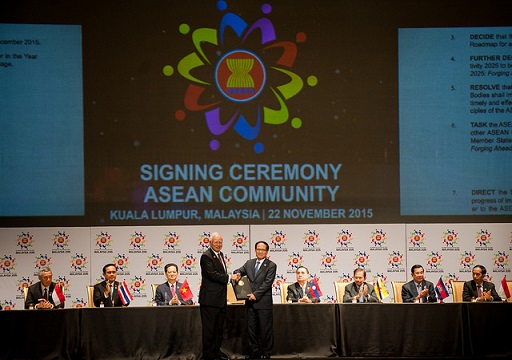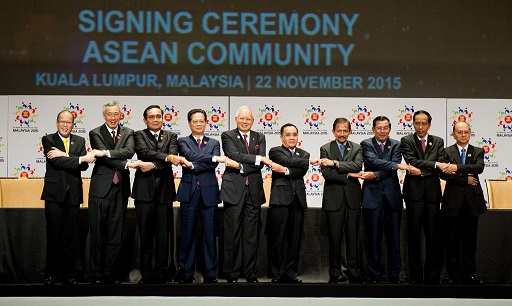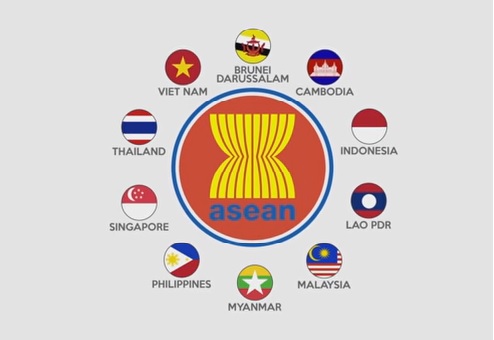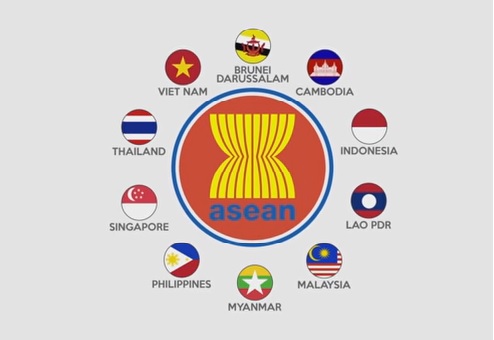By LUIS T. CRUZ
AT the beginning of this year, an important milestone began in Southeast Asia with the inauguration of the ASEAN Community.
What does ASEAN Community mean to the lives of ordinary Filipinos aside from no longer getting a visa when going as tourists to other Asean countries namely Brunei Darussalam, Cambodia, Indonesia, Lao PDR, Malaysia, Myanmar, Singapore, Thailand and Viet Nam?
For Filipino consumers, the ASEAN Free Trade Arrangement has made available a bigger variety of goods and services, at cheaper prices in the domestic market. Coffee from Indonesia, rice from Thailand and Vietnam, banking services from Malaysia, and electronics from Singapore are some examples of this liberalized regional trading regime.
For Filipino exporters, a larger market of more than 600 million ASEAN nationals for Philippine products and services are ready to be tapped. The Philippines already has a number of success stories, such as Jollibee, Liwayway Marketing, C2 green tea, Unilab, SGV Accounting Services and San Miguel beer.
For Philippine producers, there will be cheaper prices of inputs (from imports), which means more competitive prices of outputs for export and domestic consumption. According to DTI, more than 70 per cent of our imports were goods that are needed in creating primary, intermediate, and capital goods.
More economic benefits will be discussed in Economic Cooperation.
PH role in ASEAN integration
The Philippines played a pivotal role in the decision of the ten ASEAN member states to integrate more closely. It was in Cebu City nine years ago that the leaders of ASEAN decided to accelerate the target date of commencing integration to December 2015 from the original date of 2020.
On hindsight, it was than excellent decision that happened to the region that year. One only has to browse the business pages of today’s newspapers to realize the increasing economic slowdown in many parts of the world, with the exception of ASEAN. But some two decades ago, each of the ten Southeast Asian states faced many challenges brought about by globalization. Individually, they had to contend for the same export markets. Their path to industrialization is similar. And their agricultural products are competing with each other.
Outside the region, free trade areas began to emerge. Examples are the European Free Trade Association (EFTA) in 1960; Southern Africa Development Council (SADC) in 1980; Gulf Cooperation Council (GCC) in 1981; Southern Common Market (MERCOSUR) in 1991; and the North American Free Trade Agreement (NAFTA) in 1994. Because of lower tariffs among their members, products coming from Southeast Asia into their region became more expensive. Not to be left behind, ASEAN followed this global trend towards economic integration. This led to the formation of the ASEAN Free Trade Agreement in 1992. (Note: as of 2010, around 99 per cent of tariff rates in ASEAN have been lowered from zero to two per cent.)
However, outside ASEAN, regional FTAs led to greater integration to include other areas of cooperation such as labor, environment, social protection and political/security arrangements. The best example is the elevation of EFTA into what is now known as the European Union (EU). The 27-EU member countries agreed to cede some of their sovereign functions to create supra-national bodies such as the EU Parliament, Commission and Central Bank.
With the launching of the ASEAN Community this year, the ten Southeast Asian Nations similarly decided to go beyond free trade arrangements into deeper community integration. The ASEAN Community is now sustained by three pillars of cooperation which include political-security, economic and socio-cultural areas. Other than those, ASEAN did not fully adopt other features of the EU. It still remains an inter-governmental organization with sovereignty residing among member countries.
ASEAN’s cooperative activities and institutional arrangements are governed by the ASEAN Charter. The highest decision-making body is the ASEAN Summit, composed of the ten ASEAN Leaders. They are supported by ministerial bodies, senior officials, sectoral bodies and functional committees. They also meet with leaders of ten dialogue countries either individually (ASEAN+1 format) or in groups (ASEAN+3; East Asia Forum). The dialogue partners include Australia, Canada, China, the EU, India, Japan, New Zealand, Republic of Korea, Russia and the United States.
ASEAN has also created the only security dialogue in the region composed of 27 countries. Established in 1994, it is known as the ASEAN Regional Forum.
While the inauguration of the ASEAN Community began only this year, ASEAN has existed since 1967. Over these years, what ASEAN has done for the Philippines, and for the region? This will be tackled below under the three pillars of regional cooperation.

Political-Security Cooperation
Discussions about forming a regional grouping began in August 1967 when Thailand initiated talks over certain disputes between the Philippines and Malaysia and between Indonesia and Malaysia. Singapore sent its foreign minister to join the four other foreign ministers to address other issues such as the effects of the cold war, the creeping influence of communism in Southeast Asia; and the growing popularity of non-aligned movements worldwide. The Philippines was represented by Foreign Minister Narciso Ramos in that auspicious gathering. That ASEAN was established at all in spite of these difficulties, he said, meant that its foundations had been solidly laid. Thus, the five founding members put aside their animosities and mustered their political will to focus on economic cooperation and improving the lives of their peoples. Over the years, five other Southeast Asian countries joined ASEAN, namely, Brunei Darussalam, Vietnam, Laos, Cambodia and Myanmar.
To govern inter-state relations, ASEAN leaders signed the Treaty of Amity and Cooperation in 1976. The treaty prescribes mutual respect for the independence, sovereignty, equality, territorial integrity; non-interference in internal affairs; settlement of disputes by peaceful means and renunciation of the threat or use of force. Accession to the treaty eventually became one of the preconditions for ASEAN’s dialogue partners to become members of the elite group of 18 regional leaders comprising the East Asia Forum.
The treaty also became the anchor of succeeding regional security treaties and declarations. Such agreements were instrumental in creating an environment of peace and stability. This stability in turn ushered an era of more dynamic economic cooperation and people-to-people contact as the chances of bilateral disputes were prevented from erupting into open wars and hostilities. Examples of succeeding security agreements are the Zone of Peace, Freedom and Neutrality; Southeast Asian Nuclear Weapons Free Zone; and the Declaration of the Conduct of Parties in the South China Sea.
Through security dialogues, the Philippines also benefitted from regional security cooperation in addressing traditional and non-traditional security challenges such as terrorism, violent extremism, climate change, and transnational crimes such as human trafficking and drugs trade through capacity building activities and exchange of intelligence information.
Aware of the danger that secessionist groups could pose on the integrity of the national territory of members, the Philippines spearheaded the creation of the ASEAN Institute for Peace and Reconciliation. Through the Institute, the Philippines shared its experiences in mainstreaming the role of women in the peace process. In the case of the Mindanao Peace Process, the Philippines also received active support from ASEAN member countries such as Malaysia, Brunei and Indonesia.
In various ASEAN-led security fora, the Philippines also got support from like-minded countries in its position on South China Sea and in pushing for more active maritime security cooperation in the region.

Economic Cooperation
Aside from the benefits to consumers, exporters and producers mentioned above, AEC has led to many initiatives in the area of trade facilitation.
This is a very important area, because businessmen believe that trade in the region will be facilitated through simple, harmonized and streamlined trade and customs documentation as well as rules and procedures. This is a wide-ranging area, but one of the most important sectors is customs facilitation, which covers the following: the simplification of import and customs procedures, formalities, documents and practices; greater use of ICT in customs and trade related agencies to enhance import and customs administration efficiency, effectiveness and integrity;and linking up these national clearance systems of the ASEAN member countries through an ASEAN Single Window, to facilitate the flow of goods within the region.
In the area of investments, the AEC will help lead to a single production base. ASEAN is now considered as a bright spot by many financial analysts due to the marked slowdown in economic performance by China, Europe and other major economies of the world. With these developments, investors have looked to ASEAN, with its young population, a huge market and dynamic economic performance in recent years.
In the area of labor mobility, it will be an ongoing process that will begin with a limited sector of professionals and skilled labor. It will not be at the level of the EU where there is free movement of labor, although the number of professional services covered by ASEAN agreements is likely to expand in the coming years.
In the area of infrastructure development, projects carried out through public-public partnership are expected to link the Philippines to its ASEAN neighbors and the rest of the world bringing down the cost of transport in goods and facilitating travel and tourism.
In the area of small business, the interest of micro, small and medium enterprises are now at the forefront of decision-making by ASEAN bodies.

Socio-cultural Cooperation
Through ASEAN’s socio-cultural cooperation, the Philippines found a platform to push its priorities in terms of social protection, poverty alleviation, climate change mitigation and disaster management.
ASEAN’s agreements and cooperative activities cover hundreds of projects to help women and children, persons with disability, the elderly, migrant workers in difficult situations. An example is the case of the Philippine government request to the Indonesian government for stay of execution of Filipina death convict Mary Jane Veloso, which was granted on April 29, 2015. The Philippines invoked ASEAN agreements on trafficking in persons and on mutual legal assistance treaty, in the light of new evidence to prove that Ms. Veloso was an apparent victim of human trafficking. She was accused of carrying over two kilos of drugs in her luggage.
On the institutional front, the ASEAN Humanitarian Assistance (AHA) Center based in Indonesia prepositioned its staff in Tacloban, Leyte one week before Typhoon Haiyan struck in November 2013. It was among the first to respond to the victims. During the critical hours, AHA Center’s mobile communication facilities provided vital information on the situation on the ground. Its satellite phone was even used by Philippine officials to contact Malacanang on that fateful morning. AHA Center was also in the forefront of developing rehabilitation plans for four localities and in mobilizing international assistance, in accordance with the ASEAN agreement on disaster management and emergency response.
End Notes
The inauguration of the ASEAN Community this year is not the culmination of 49 years of regional efforts for closer regional cooperation. Rather, it should be considered a milestone, or an indicator of better things to come. In fact, ASEAN leaders signed another 10-year development cooperation plan to further deepen integration at their meeting in Kuala Lumpur in November 2015.
Three blueprints divided into sectoral areas of cooperation in the political-security, economic, and socio-cultural fields have been mapped out. ASEAN committees and institutes will largely carry out their implementation.
As the objective during the next ten years of the regional association is to create a people-oriented and people-centered ASEAN, it behooves everyone to take particular interest in policies and programs that affect their sector. For Philippine civil society groups, the youth, businessmen, small entrepreneurs, and other stakeholders, it would be wise to network with Philippine government agencies involved in ASEAN functional cooperation. A good starting point is to engage the coordinators for each of the three pillars, namely, the Department of Foreign Affairs for political-security cooperation; the Department of Trade and Industry for economic cooperation; and the Department of Social Welfare and Development for socio-cultural cooperation.
The author, Luis T. Cruz, was a career diplomat for 32 years until his recent retirement. His last position was Assistant Secretary and head of the Office os Asean Affairs.
